Meyer's System for Dusack
After his treatment of longsword in his book Gründtliche Beschreibung der Kunst des Fechtens, Joachim Meyer turns to the Dusack next. A dusack originally is a curved, single-edged one handed sword a bit akin to a cutlass, but for Meyer it primarily serves as a blunted, wooden practice and competition weapon (at least that is what is depicted) to illustrate the use of a heavier one-handed sword primarily used for cutting.
The original text has a very clear structure - Meyer starts by outlining the basic building blocks, i.e. guards and cuts, then proceeds to develop a theory of how attacks and defenses should be organized and finally, in the latter half, he describes specific plays from the various guards with the understanding that the guards are to be seen as 'breakpoints' in an exchange (i.e. if a cut has been met with a counter-cut from above, the defender is now in a particular guard - Schnitt - what should he do from here?)
The following is an attempt to render the essentials of Meyers manual in my own words. I do not attempt a full translation, but I will quote and translate from the original where appropriate. Meyer assumes a right-handed fencer in his examples and descriptions, I make no attempt to generalize that.
Basic cuts and guards
There is a close relationship between cuts and guards, because guards just mark the endpoints of cuts - or in Meyers own words
For in all cuts and techniques you will always move from one guard to the other (1)
The basic cuts can all be understood from the Meyer square figure that is supposed to be imagined to be drawn centered across the opponent's chin:
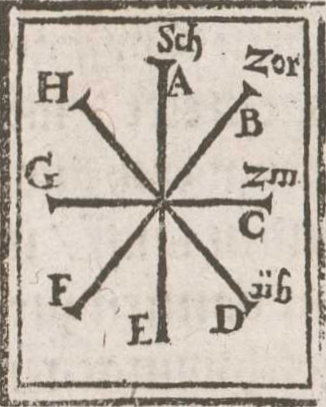 The Oberhau is a vertical cut descending from A to E, the Zornhau a diagonally descending cut from B to F, the Mittelhau is done from C to G and the Unterhau diagonally ascending from D to H. All cuts except the Oberhau also have a left side version.
The Oberhau is a vertical cut descending from A to E, the Zornhau a diagonally descending cut from B to F, the Mittelhau is done from C to G and the Unterhau diagonally ascending from D to H. All cuts except the Oberhau also have a left side version.
The footwork is organized as follows: Initially, if the sword is on the right, the left foot is facing forward whereas if the sword is on the left, the right foot is forward but the left foot is more to the side than behind. The initial attack is then made with a passing step (from the right) or advancing step (from the left), in both cases the right foot is then forward. As subsequent cuts are done, the right foot remains forward and the left foot is drawn in to the right foot to allow a new step forward (or the right foot is moved to the left when stepping backwards).
Cuts can be done as full cuts, i.e. cutting through the center point. This leads to the following guards as starting- or endpoints (each of them can occur left and right, dependent on where the cut starts and ends):
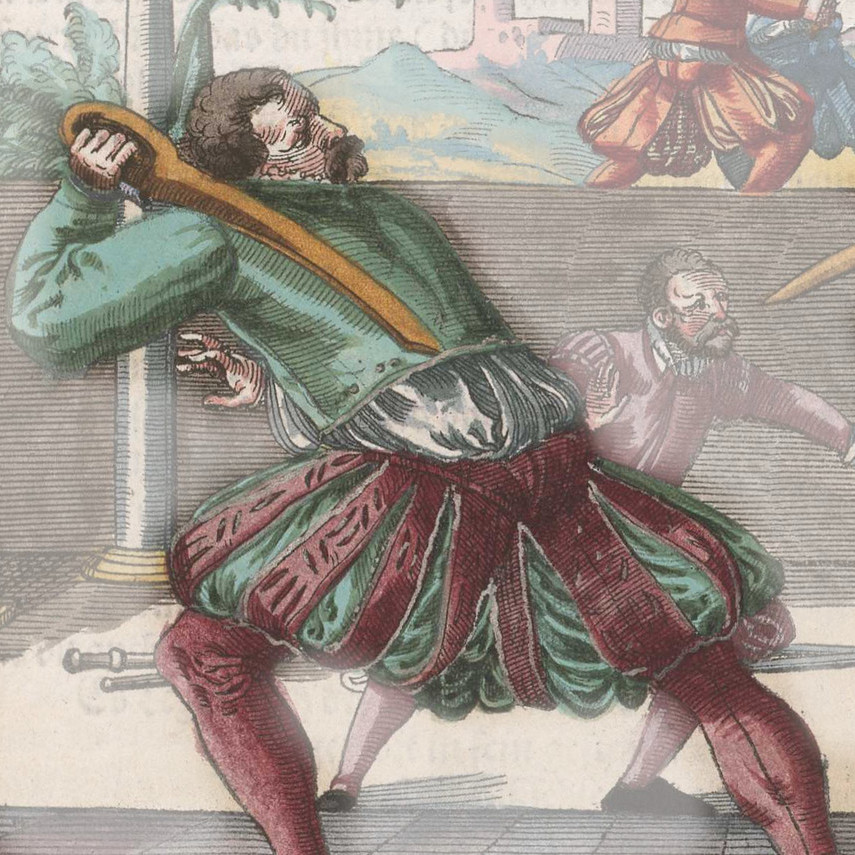
| 
| 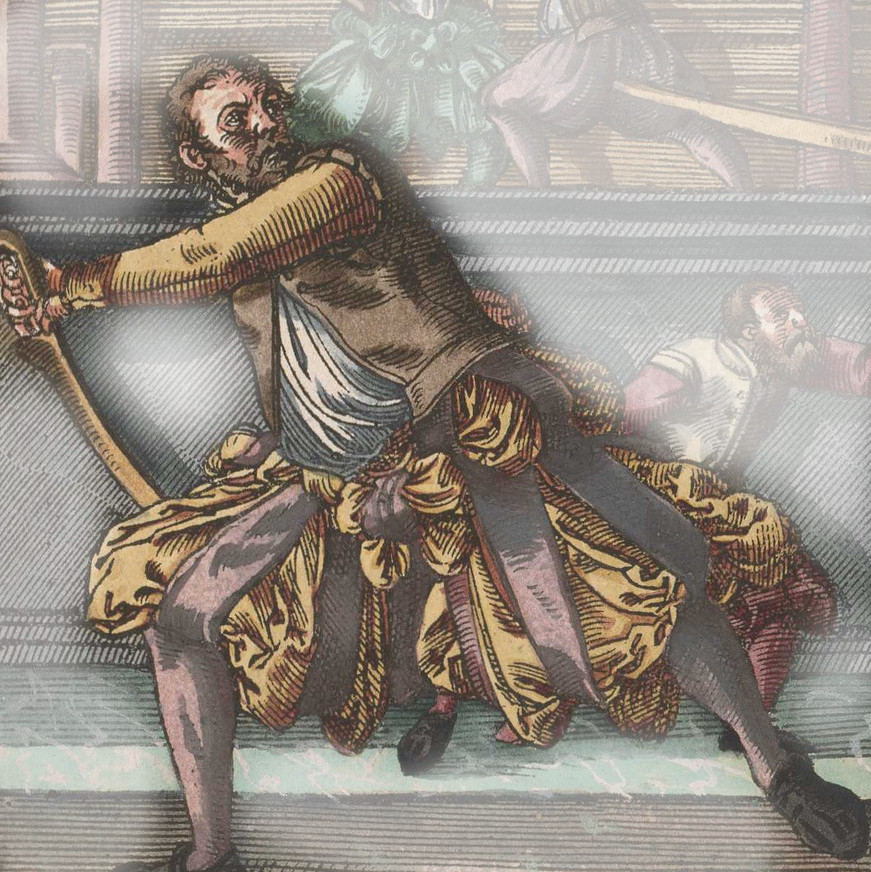
| 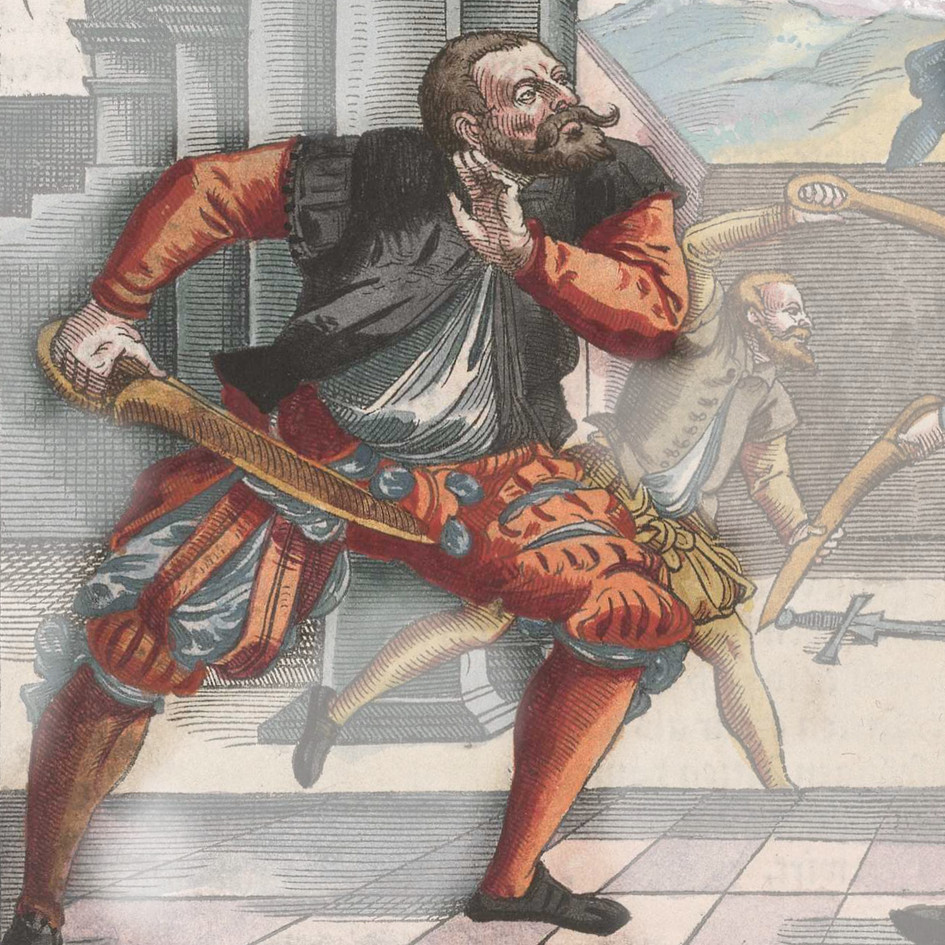
| 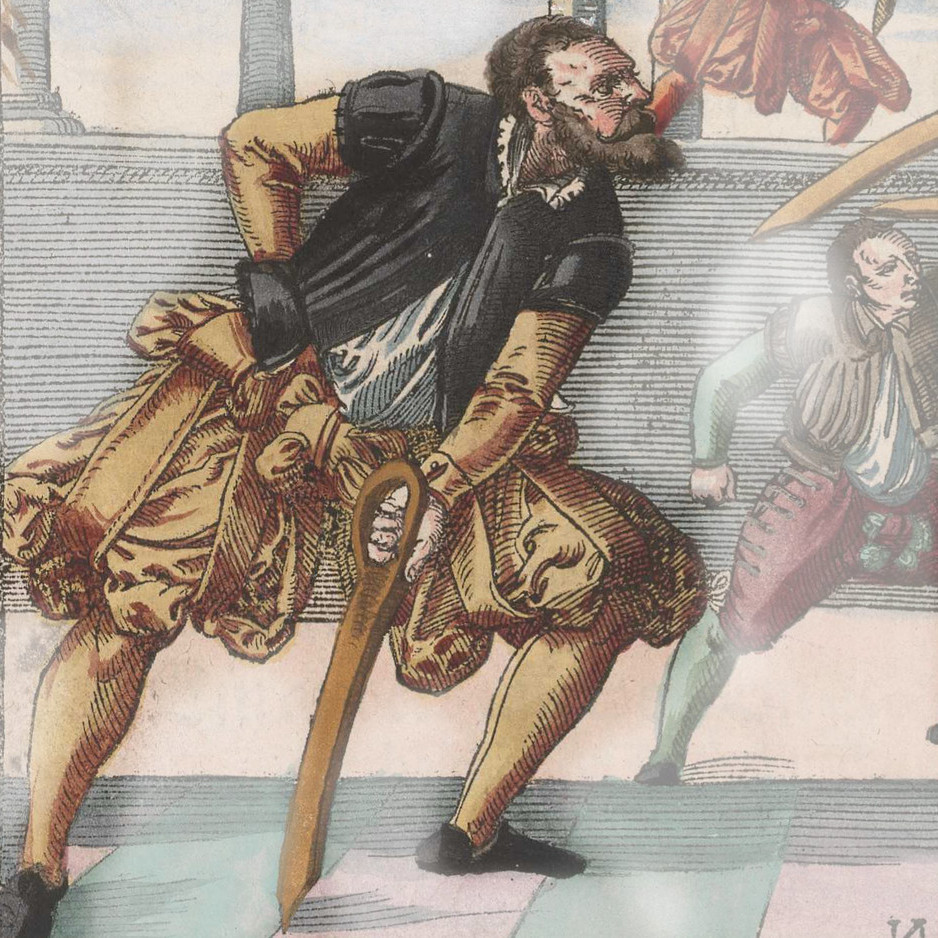
|
| Zornhut
| Stier
| Mittelhut
| Eber
| Wechsel
|
(note that a part of the illustrations has been flipped horizontally from the original to bring out the relationships between the body posture better - the drawback is of course that some fencers now appear left-handed)
For instance a diagonally descending Zornhau from Zornhut ends into Eber, an ascending Unterhau might end in Stier and so on.
In addition there are guards on the vertical center line which do not have separate left and right versions. Cuts from the guards described above can also be done to the center, i.e. they then end in Langort. Basically the named guards on the center line follow a vertical Oberhau - Meyer names Schnitt and Bastei as the typical contact points for descending and ascending parries, so just as with Langort their value does not lie in their usefulness at the beginning of an exchange but as recognizable break points within an exchange from which the student can learn the appropriate techniques.
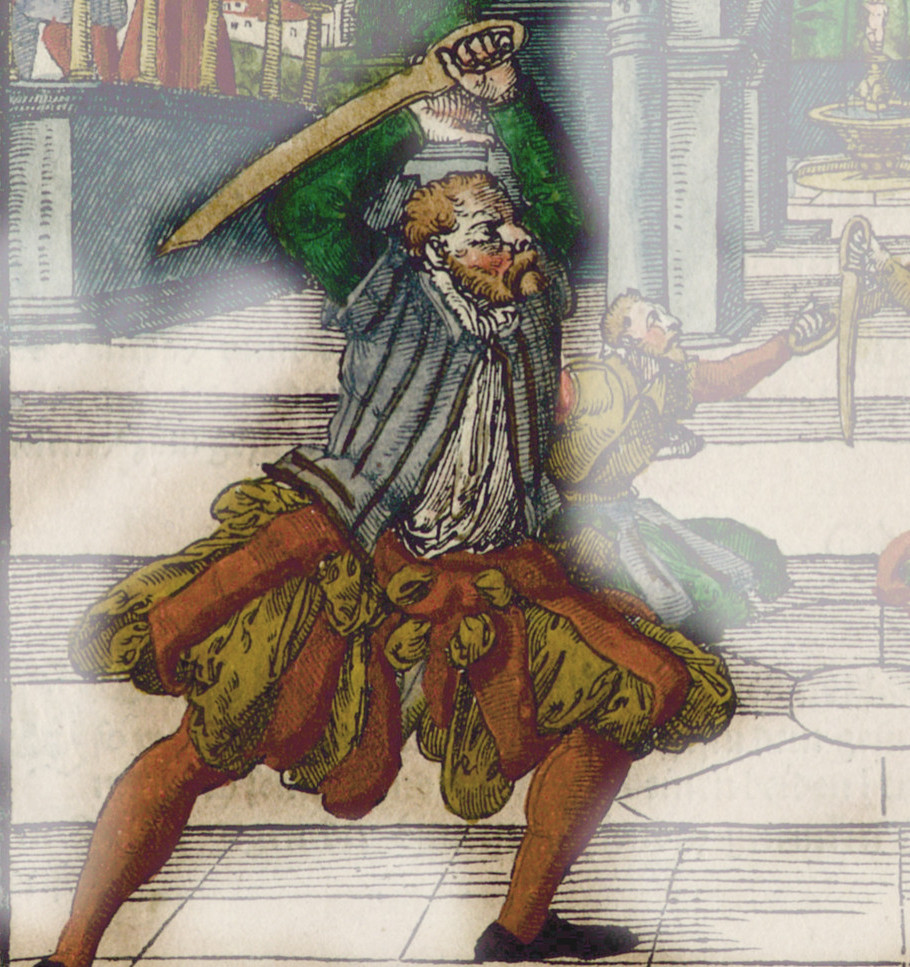
| 
| 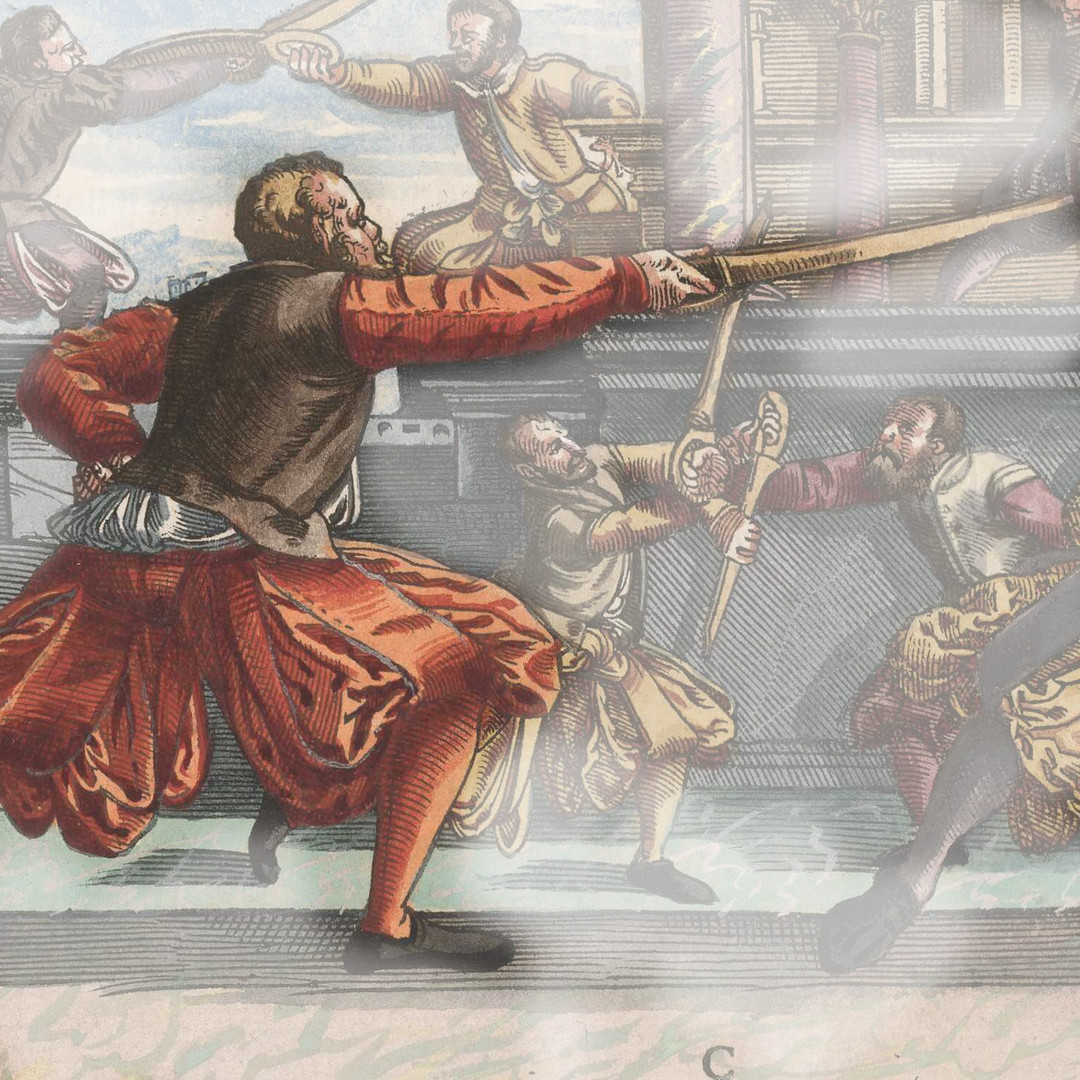
| 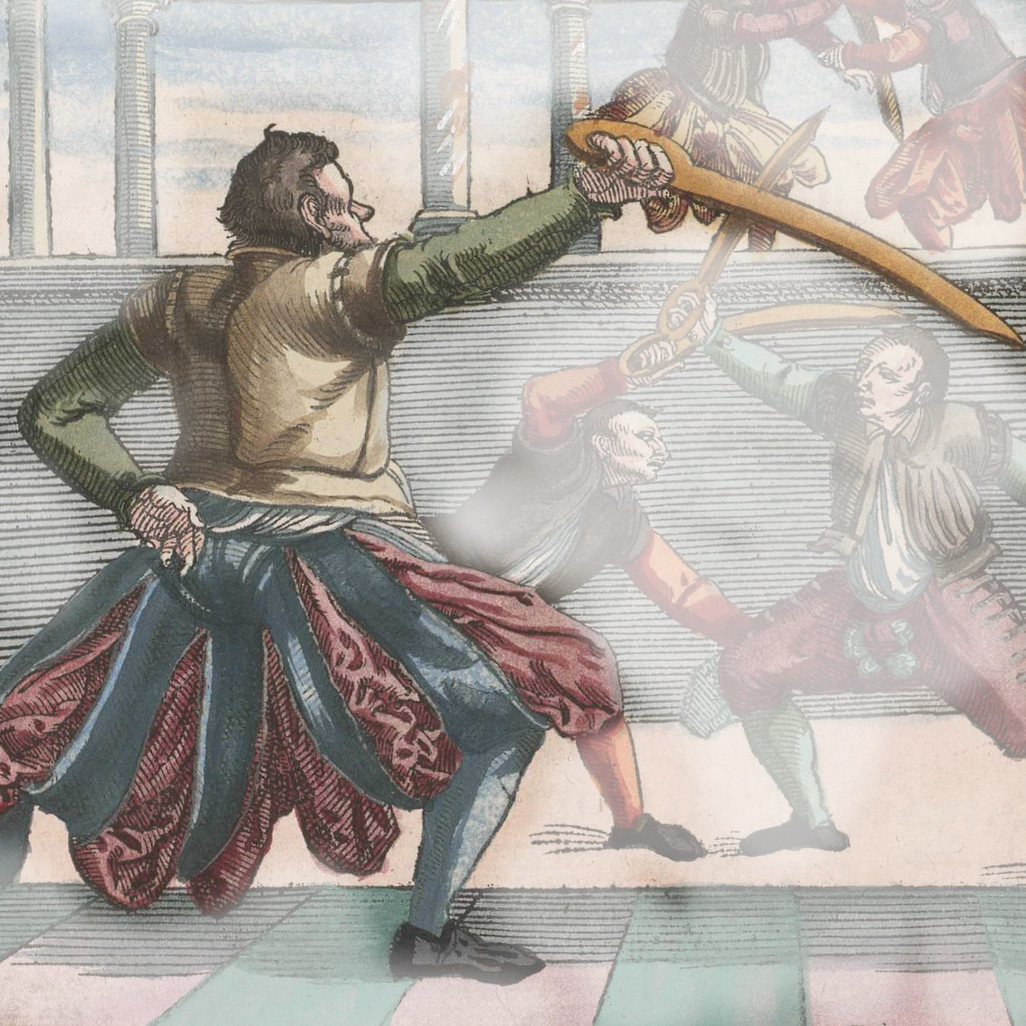
| 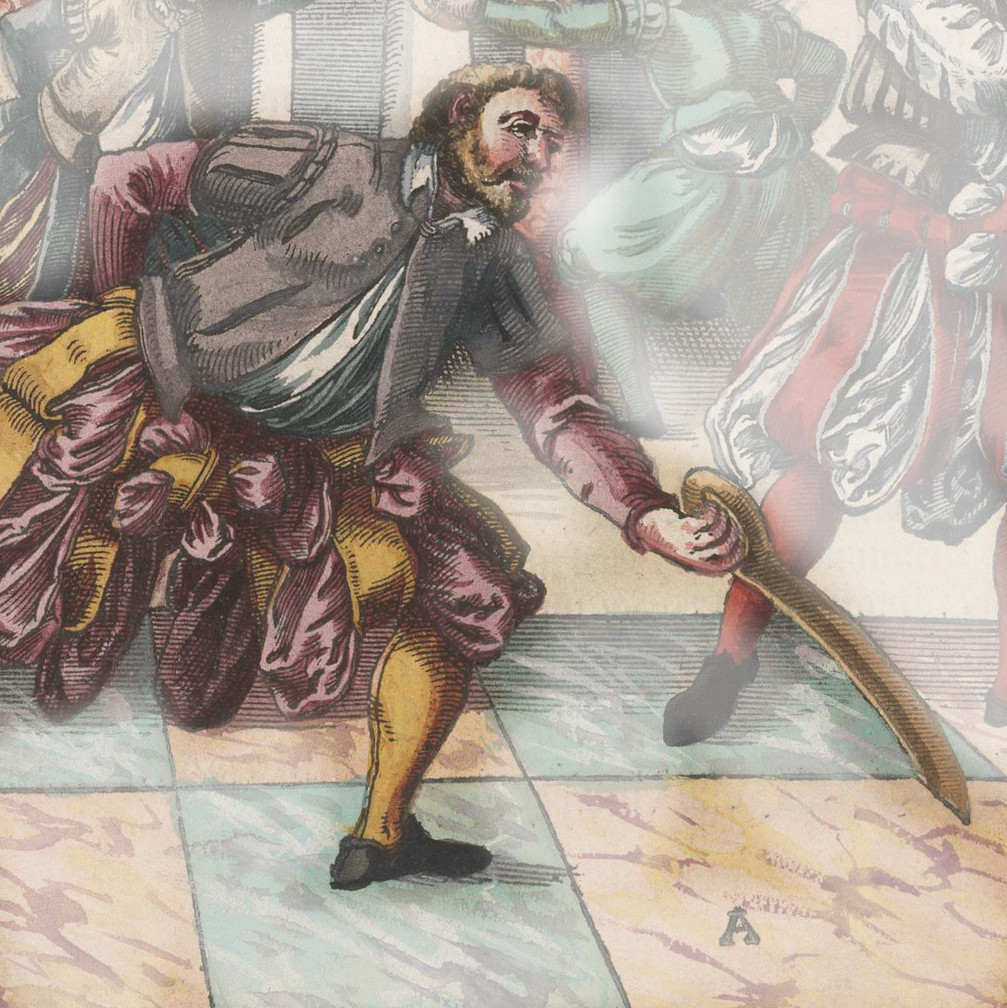
|
| Wacht
| Schnitt
| Langort
| Bogen
| Bastei
|
(note that a part of the illustrations has been flipped horizontally from the original to bring out the relationships between the body posture better - the drawback is of course that some fencers now appear left-handed)
Zufechten as dynamical situation
Meyer does not envision guards as static positions to be held, instead he recommends to always change from one guard into the other while looking for a good opportunity to attack. In his own words:
Thus fourth you shall know, that you should not remain in any guard but always change from one into the other, and not only because you aim to bait him, but to confuse him so that he can't know what piece you will fence or what he should fence against you. (2)
It should be clear from the previous section that one function of cuts in this system is to reposition the blade. In fact, for instance the Sturzhau seems to have this as its primary purpose. This is a cut that brings the weapon from Zornhut (or possibly Wacht) into Stier while changing the side. It works by starting out with an Oberhau and when the hand is at face height, the tip is dropped and brought around in a vertical circle (the Sturnz that names the cut) till it faces the opponent again.
Secondary cuts
Meyer distinguishes secondary cuts from the main cuts along the lines. Some of them are done with the false edge of the weapon. For biomechanical reasons, they may require a change in grip from a handshake-grip to a 90 deg rotated thumb grip (in which the thumb can rest on the flat of the blade). Others have separate names for historical reasons and/or follow more complicated patterns.
Cuts with different grip or biomechanics
| Sturzhau: A respositioning cut used during Zufechten from Zornhut into Stier with a change of side. It starts with a vertically descending cut, at face level the tip is dropped and brought around in a vertical circle till it faces the opponent, at which point Stier (with the hand more forward) is reached.
|
| Krumphau: Requiring a thumb-grip. the Krumphau is done sideways by rotating the wrist, either from above or from below.
|
| Kurzhau: 1) counter-cut to the face that is used against the opponent's right Oberhau or Zornhau and done with the false edge to the face 2) more generally any cut that is done below the opponent's blade with the aim to block it.
|
| Brummerhau: From a high bind, the cut is done by changing into a thumb grip, stepping well to the right while doing a right false-edge cut to the head while the hilt of the weapon remains in the bind.
|
| Windhau: A curved cut that reverses horizontal motion (i.e. a cut that begins from upper right approaches the center point but then ends at the lower right) that can be done from both sides.
|
Named cut combinations
| Zwingerhau: 1) an alternative name for a defensive horizontal cut from Mittelhut (in essence a Mittelhau) 2) a feint in which the blade is offered (e.g. in Schnitt) - once the opponent cuts towards it, the tip is dropped while the hand moves to the right shoulder and then, while the opponent's arm is still descending, a cut towards the head is made.
|
| Weckerhau: In essence, this is a strong Oberhau to force the opponent to block, if he does it continues as a thrust to the face, if the opponent counters by raising his hand, a false-edge cut to the arm is done.
|
| Rosenhau: A feint against an opponent waiting below - the cut starts out as if aiming at the head, but then avoids the opponents weapon on the outside to go below it and come around in a vertical circle on the inside line to hit the head from the other side.
|
| Gefehrhau: A quick cut from the wrist (almost a thrust) beneath the opponent's weapon when he raises it to strike - if done correctly the attack strikes a hit and blocks the line for the opponent's attack.
|
| Entrüsthau: 1) A horizontal cut against an opponent's attack from above with the idea to get a bind 2) from Eber, the fencer uses the left arm to support the dusack when catching an attack from above, then thrusts to the head and follows with a horizontal cut to the face from the other side
|
| Fehlhau: A feint in which the dusack is pulled back to avoid the opponent's blade (this seems to be akin to Zucken in Liechtenauer/Meyer terminology for longsword).
|
| Schnellhau: A feint in which the dusack is raised from Bogen to Wacht but then brought into a left Unterhau to the opponent's right arm.
|
| Bochhau: A strong cut to the blade with the aim to move the opponent's dusack against his face to make the opponent react.
|
| Kreuzhau: Two Zornhau cuts in quick sequence, one from the left and the other from the right.
|
Defense and attacking openings
The primary mode of defense is to cut against the opponent's blade. Generally Meyer advises against completely static blocks:
This defense you should not, as some are apt to, do by merely holding their weapon against a strike - if you want to parry a strike, you should meet his Oberhau with your arm extended weapon rising up into the air - the higher you catch his cut in the air, the more you weaken him and this means your following cuts will have more potential and you can finish them more safely. (3)
Nevertheless, he distinguishes between Versetzung, i.e. a relatively slow-moving parry using the center-line guards Schnitt, Langort and Bastei and hard cuts against the opponent's blade.
As for the parries, the vertically descending Oberhau is the main defensive motion when coming from above, the Unterhau when coming from below. In both cases, the idea is to do a point-in-line cut ending around Langort (or lower) to gain a good position for a counter-thrust after the parry has been done. In addition, the edge should be turned against the incoming cut.
As far as defensive cuts are concerned, the general rule is that the second cut (Nachhau) breaks the first one and so any intersecting cut will do to ward off an attack, but of all cuts the descending Oberhau is the most powerful.
First, the Oberhau (if you use it against the opponent's dusack towards the strong of his right hand) breaks all other cuts that are done against you, be it from below, diagonal or horizontal. However, the Zornhau or the horizontal Mittelhau breaks the Oberhau. Thus, also note that always two equal cuts directed against each other with proper footwork cancel each other and parry, but he who manages to come with his weapon above the other accomplishes most with his cuts.
Cuts then serve three purposes - they can be a provocation to get the opponent to react, they can be a defense to ward off a strike and they can be an attack with the aim to hit (in that section, Meyer omits that cuts may also serve to position the blade). Provocations should wisely not be aimed towards an opening but towards the weapon.
As he stands before you in a guard and you can't cut through his block, or if he is doing his defense in a way that you don't dare to hit a provoking cut to an opening without being harmed, so note and pay attention that you start to hit against his weapon, close to his hand (5).
Openings in a static situation should in fact almost never be attacked directly (because the opponent may have prepared a counter-cut for precisely that situation) - the best time to attack an opening is when the opponent's weapon is just moving away from it. This can happen in Zufechten if the opponent changes guards - each transition opens a short time window to get behind the blade. It can also be a good idea to block a cut and then counter-attack the opening where it came from.
Alternatively, the movement of the blade can be the result of a feint - a threat compells the opponent to move his weapon, as soon as the attacker observes the motion he can jerk his own weapon around to attack into the resulting opening. Yet another alternative is to chain two ore more cuts in a quick sequence, the first with relatively low commitment, with the idea that if they come from different directions, at least one of them will hit.
Meyer generally favours offensive techniques and believes a variety of good offensive plays to be superior to a set of counters and breaks against specific attacks:
It is in the nature of fencing that you cannot easily know or in the heat of an exchange what exactly your opponent will fence against you, and even less quickly decide what specific counter-technique would be appropriate. Therefore I prefer the fencer who knows many techniques and few specific counters and can employ these techniques in Vor und Nach - let his opponent worry about the counters and breaks, if one of his pieces is broken, he can easily have two new ones in the works. (6)
Techniques from specific guards
The main part of Meyers text is devoted to describing specific techniques and sequences from the various guards. Conceptually (and that is my interpretation), it seems that all the sequences found there can be divided into a) a tactical opening and b) a quick follow-up.
The purpose of the tactical opening is either to initiate an attack (without danger or a counter or double-hits) or to deal with an attacking opponent and quickly re-gain initiative. In both cases, the follow-up serves to overwhelm the opponent by chaining attacks from different angles.
In content, the difference is usually that the tactical opening in the attack involves feints or attempts to initiate a bind, in the defense a motion optimized from the guard to get the upper hand whereas the follow-up is usually just a sequence of cuts.
It would seem that the two decouple - while Meyer usually describes a particular follow-up sequence to a tactical opening, in practice any follow-up sequence would do just as well (provided it changes the direction of the attack sufficiently - of course simply alternating left and right cuts won't do any good). This is good to keep in mind when studying Meyers long descriptions of follow-ups - what is particular to a guard and should be memorized is usually only the opening sequence.
With some regularity, Meyer also gives instructions for footwork. This is always based on the same principles.
- in the off-center guards, the left foot is in front if the weapon is kept right, if not the right foot is in front and the left is only slightly to the rear and mostly to the side
- with an attack from right, the first step is a passing step that brings the right foot forward
- with an attack from left, the first step is an advancing step that brings the right foot forward
- for all subsequent attacks, the right foot stays in front and moves with the attack, the left foot follows
- in defense, the step is always away from the cut, i.e. if a cut comes from the left side, the fencer has to step right
In his description, Meyer frequently mixes descriptions of directions like 'inside' (i.e. to your left while your right side is facing forward) and 'outside' (to your right) with 'opponent's left' and 'opponent's right' as well as 'your left' and 'your right' - I have in the following regularized all descriptions to the fencer's own reference, thus 'left' always means 'your left'.
Techniques from Wacht
| Wacht is a strong defensive position because it allows to parry any attack from above and hence come over the weapon of the opponent, which gives an advantage in the subsequent exchange.
The general idea of defense is to always step away from an attack while striking against the blade with an Oberhau, this gives a superior position to continue.
| 
|
Techniques to use from the guard if the opponent is attacking:
- step away from a cut and respond with a strong cut towards his head above his blade, follow with a Mittelhau from the other side to the face, use other techniques like Kreuzhau as needed to follow up
Techniques to use from the guard if the opponent is not attacking but trying to wait:
- feint a cut to the right arm, once the opponent moves to block, change into an attack left
- cut a vertical Oberhau, feint an attack with the false edge, if the opponent moves to parry, cut horizontally to the arm, finish with Kreuzhau
- feint an attack cut, if the opponent does a counter-cut change the attack cut to a defensive cut to fall above his blade and get an advantage
- start with two Oberhau / Zornhaus to the face to drive the opponent's hands up, follow with two Mittelhaus right and left
Techniques from Stier
| Stier is an offensive position in that it allows direct thrusts as well as cuts from above and below, hence it is difficult to guess for the opponent from where an attack might ultimately come.
Of course, since cuts can be defensive in nature just as well, the guard also allows for many defensive plays.
| 
|
Techniques to use from the guard if the opponent is attacking:
- if the opponent is attacking from left, step right and do a strong counter-cut from above, use the momentum to let the weapon fly through into left Stier, cut Mittelhau into right Stier, feint a thrust and do a Kreuzhau
- if the opponent lifts his hand to strike, do a Mittelhau against his hand, then step well to the left and cut a Zornhau to his head across his right arm
- if the opponent is attacking from right, step left with your right foot and turn your body away from the strike while letting the point of the dusack drop to let the attack slide off, then bring the weapon around for a counter to the head
- thrust to the face into Langort while winding the long edge against the opponent and stepping away from the cut, if he parries the thrust, pull back continue with an Unterhau to the arms, followed by Oberhau to the face
Techniques to use from the guard if the opponent is not attacking but trying to wait:
- if the opponent brings his hand too high in Zufechten, do a right Unterhau threatening his arm, end in left Zornhut, cut left Zornhau and finish with techniques such as Kreuzhau as needed
- if the opponent has his defense too low in Zufechten, do a vigorous Mittelhau from right to his face, follow with Oberhau
- do a vigorous thrust against his neck or torso below his dusack (see illustration below), as the opponent moves down to block, pull back and cut horizontally to his face, followed by a vertical Oberhau, continue as needed
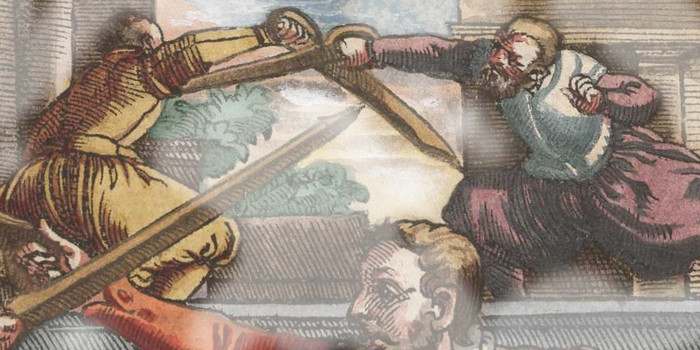
- if the opponent has his weapon too far extended, cut from the right against the weak of his blade, while he recovers and moves for a counter, bring the weapon around your head for a second horizontal attack from the right, once his counter is caught, step well left and do a false-edge cut to his head (see illustration)

- start with a thrust from right, once he moves pull back and do a false edge cut from lower right while stepping right
- if the opponent is in a low guard, feint a strong Oberhau to the head, as he brings up his weapon to block move to thumb-grip and do a quick false-edge cut from left to his arms, follow with right Mittelhau to the face
- if the opponent is in Bogen, cut strongly towards his hilt, let the blade come around left and while he prepares to counter, cut from left to his face
- if the opponent is in Bogen, cut strongly from above, as he blocks and the blades meet, thrust to his face, if he raises then hands cut a right Mittelhau to his face, if he blocks, thrust
- cut a strong Zornhau from right, continue with strong Unterhau coming back the same line
Techniques from Zornhut
| Zornhut allows as fast Zornhau (which is arguably the strongest cut one can do). Meyer sees surprisingly little tactical difference between Stier and Zornhut except that while feints from Stier can be initiated with a thrust, from Zornhut a cut has to be used as threat.
| 
|
Techniques to use from the guard if the opponent is attacking:
- if the opponent attacks your left side from above, step well to the right and cut hard towards his head, pull your weapon into Wechsel, if he now attacks your right, step well to the left and parry his attack, let your dusack fly around your head use a Windhau to attack his arm
- if the opponent attacks your left, step well to the right and cut a hard Zornhau towards his hand, before he recovers attack his opening from your left
- if the opponent attacks your right, step well left and cut, as his strike is coming, a left Zornhau to his head, as the blades meet, stay in the bind and thrust towards his head, as he parries, pull back and cut into the opening he just created
- if the opponent cuts left, cut a strong Zornhau against it, as the blades meet thrust towards his face and wind your blade against a possible counter, as you parry that counter, raise your hand and cut a false edge cut to his arm, if he tries to evade, pull and cut into his face
- if the opponent attacks from above, parry with point hanging left, then do quick false-edge cuts from below to his face, follow with true edge cuts as needed
Techniques to use from the guard if the opponent is not attacking but trying to wait:
- feint a Zornhau, then pull short and thrust to his torso below his blade, if he manages to parry, pull and cut a Mittelhau above his blade to his face
- feint a thrust to his face, then cut a right Mittelhau below his weapon, follow with right Zornhau, left Zornhau and finally left Unterhau to the arm
Techniques to use from left Zornhut/Stier if the opponent is attacking:
- if the opponent attacks from right, step well left and cut a hard Zornhau such that the dusack is next to your right upper leg, cut a strong right Unterhau, left Unterhau, right Mittelhau and finish with Oberhau
Techniques to use from left Zornhut/Stier if the opponent is not attacking but trying to wait:
- change left Oberhau with right Unterhau till you spot an opening, then attack it, finish with Kreuzhau
- change left Oberhau with right Unterhau, emphasize the Unterhau to threaten hands, if he moves to block, cut a left Zornhau to his face, then follow from right
- cut a left Zornhau, follow with Unterhau left and right, then left Mittelhau, thrust to the face and Oberhau
Techniques from Schnitt
| Schnitt (also referred to as 'straight parry') is somewhat less of a guard and more the result of high parry in the center line. The guard differs from the more active stances in that it has the dominant foot in front already and hence does not allow as rapid advances, but Meyer praises it for its excellent defensive capabilities.
There are no offensive techniques given for this guard.
| 
|
Techniques to use from the guard if the opponent is attacking:
- if the opponent strikes to the face, wind the blade against the attack, catch the attack to the left while stepping right, feint a direct cut to the face but pull back and do a right Mittelhau instead, follow as needed
- after parrying an Oberhau in Schnitt, pull into left Stier and follow with Mittelhau or Unterhau
- after parrying an Oberhau in Schnitt, pull back and do a thrust from the right, then pull back again and cut an Oberhau to the opponent's face
- if the opponent attacks right, parry and follow with a right Unterhau, let the dusack fly in a horizontal circle above your head and finish with Kreuzhau
- if the opponent attacks right, parry and move forward in the bind, do a quick cut from the bind into his torso, pull back and follow as needed
- if the opponent attacks right, parry and cut into Mittelhut, from there fence with techniques given there
- if the opponent cuts a high Zornhau to your left, more to the blade than to the body, do not parry but let the point sink below the attack while stepping well left and cut from the outside line
Techniques from Bogen
| The general idea of fencing from this low guard is to take an attack with a hanging parry from below (see illustration below), let the opponent's blade slide down and then cut into the resulting opening above.
The guard has the advantage that the opponent cannot open the exchange by cuts to the blade.
| 
|
 Techniques to use from the guard if the opponent is attacking:
Techniques to use from the guard if the opponent is attacking:
- if you have parried and the opponent tries a follow-up but brings hands too high, cut a Mittelhau to his hands, if he brings hands too low, do it to his face, follow as needed
- if the opponent misjudges distance in Zufechten, do not block but step back and if his weapon misses, counter and follow as needed
- if you have parried, cut a left Mittelhau to his face, follow with right Mittelhau
- if the opponent attacks with Oberhau pull the dusack left and cut a strong Mittelhau left for a single tempo counter-cut
Techniques to use from the guard if the opponent is not attacking but trying to wait:
- pull into left Mittelhut, do a left Mittelhau, let the dusack move around and cut a left Zornhau, then cut a right false-edge cut to the opponent's hand or face
- move the dusack up as if you would cut an Oberhau but change into a left Unterhau during the motion, follow with right Unterhau and Kreuzhau
- if both are in Bogen, bind and try to hit with your tip, if the opponent raises the weapon, follow with Unterhau to his head
Techniques from Eber
| Eber is a low guard in which the sword is held next to the hip. Meyer explains that it is only used from the right. The low guards offer good defense against high attacks. The usual defense is to meet a cut from above in a hanging parry, let it slife off and then counter into the opening.
| 
|
Techniques to use from the guard if the opponent is attacking:
- catch a high cut with a hanging parry, thrust to his chest, if he defends continue with Kreuzhau
- catch a high cut with a hanging parry, pull out and thrust low right to his face, if he parries finish with Oberhau
- catch a high cut with hanging parry, do a false-edge cut around his dusack to his hear, step well left and do a Windhau to his arm
- catch a high cut with hanging parry, wind the true edge against him and try to attack (see illustration), step way to the left and cut a Windhau to his arm, if he moves his hands too far down continue to the face
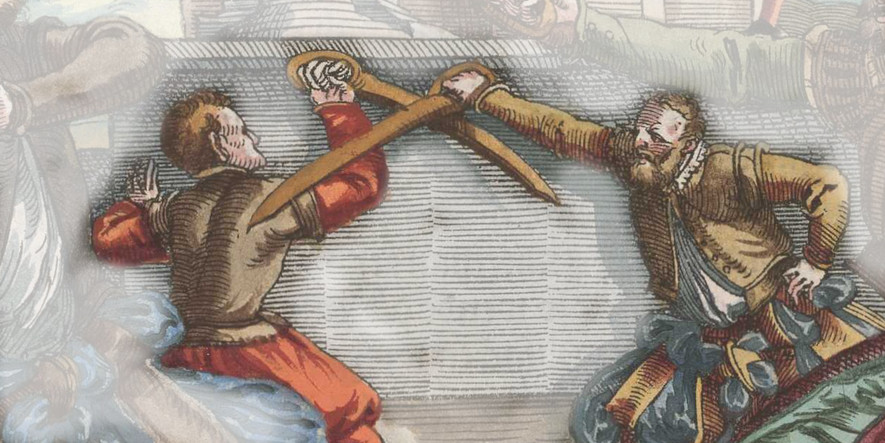 Techniques to use from the guard if the opponent is not attacking but trying to wait:
Techniques to use from the guard if the opponent is not attacking but trying to wait:
- feint a high thrust, pull back and thrust low
Techniques from Mittelhut
| Mittelhut is the natural endpoint of a Mittelhau, but also other cuts end there if one allows the dusack to swing around. Most techniques of Stier and Zornhut can also be used from here, thus Meyer keeps the section relatively short.
| 
|
Techniques to use from the guard if the opponent is attacking:
- cut a left Zornhau against an attack while stepping well left, follow with a cut from right
- if the opponent cuts from above, cut strongly against it from below while stepping left, bring the dusack around your head and follow with a Windhau to the arm
- cut a horizontal left false-edge cut against an attack while stepping left, if he doesn't hold strong against you, push down with your strong while doing a true-edge cut to his face, finish with a Mittelhau - if he is strong, go around with a false-edge cut right into Mittelhut, follow with Kreuzhau
Techniques to use from the guard if the opponent is not attacking but trying to wait:
- cut a Kreuzhau through his face
- cut Mittelhau left and right through his face
- if the opponent is in Bogen or Schnitt, step well left and attack his arm, if he moves to block pull back and attack his face instead
- if the opponent is in Bogen or Schnitt, do a false edge cut against his face (see illustration)
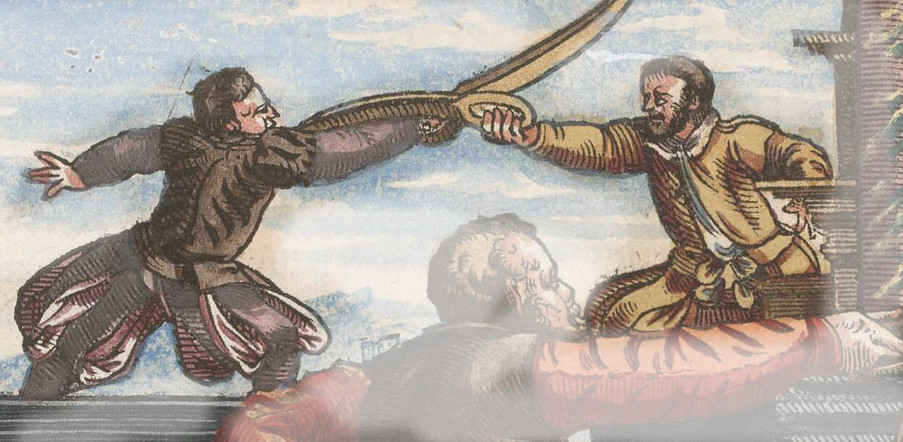
- if the opponent is in Bogen or Schnitt, cut with the flat to his arm, pull back, move the dusack around your head and cut a false-edge cut from low right to his arm such that you come to left Zornhut, follow with techniques as needed
Techniques from Wechsel
| Wechsel is a low guard with the tip of the weapon resting on the ground. According to Meyer, it has its name from being the endpoint of a Wechselhau (a diagonal cut from above that brings the fencer from left to right or vice versa).
The guard has a left and right version, but Meyer doesn't seem to think it is a very desirable position to defend, the only defensive technique given assumes that a fencer is in the guard because he missed a cut.
| 
|
Techniques to use from the guard if the opponent is attacking:
- if you missed and are in right Wechsel and the opponent attacks, cut a strong Unterhau upwards, let the dusack fly around your head and cut a Zornhau right, if you bind, thrust
Techniques to use from the guard if the opponent is not attacking but trying to wait:
- if the opponent is in Bogen, meet his blade from below and yank upward, threatening to thrust - if he raises hands to block, cut into his opening
- if the opponent is in Bogen, thrust from lower left below his blade, as soon as your tip faces resistance, bring up your hand but leave the point towards his chest, if he tries to defend, step right and cut to his face
- feint a missed cut into left Wechsel, as the opponent attacks above, do a true edge cut upward to parry, wind your point to his face and thrust, as he parries pull back and do a right false edge cut to his ellbow and cut an Oberhau while stepping back
Techniques from Bastei
| Bastei is a low center guard with the tip lower than in Bogen, similar to Alber in longsword-fencing. The idea to defend from here is to catch an attack from below and then thrust.
| 
|
Meyer doesn't describe any particular techniques from this guard, presumably the principles of fencing are well laid-out at this point and examples have been given aplenty.
Techniques from the bind
The bind is a common situation in fencing. It can arise from a parry or it can be initiated intentionally as part of an attack.
The general rule in a bind is to always wind the tip of the blade towards the opponent and the edge towards his blade and then try to thrust. The concept of Fühlen (sensing the pressure in the bind) is central for what to do - whether to thrust or evade and cut around. If the opponent is strong in the bind, it is easier to cut around or go below his weapon, if he is soft it is possible to push against him and then cut (however Meyer warns against being careless with this).
- wind the tip towards his body and thrust
- cut along the opponent's blade
- use Durchwechseln (quick lowering and raising tip) to get to the other side of his blade, then attack
- in a low bind in Bogen, step forward to take away his space, then pull your weapon upward through his face
- use winding cuts while pushing the strong against the opponent's blade
- if you bind on Bogen with a straight parry (e.g. from an Oberhau, stay in the bind and wind the long edge to his face (or whatever opening presents itself, see illustration below), if he raises hands, pull back and cut a Mittelhau to his hands, follow as needed
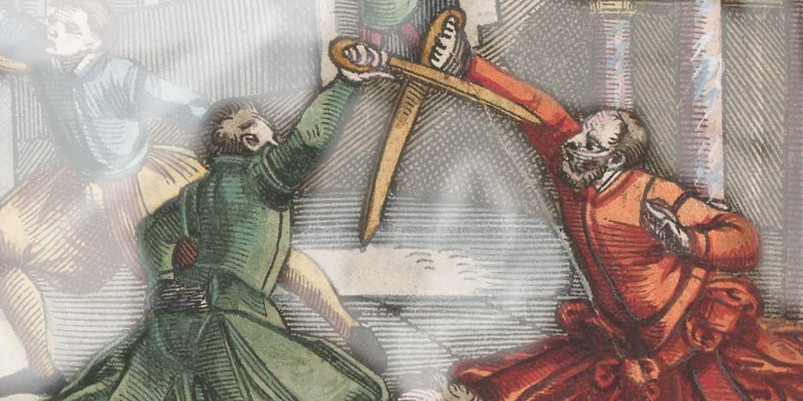
Techniques against a particular guard
Sometimes Meyer lists techniques to attack a particular guard under the heading of techniques from a particular guard - for the sake of clarity, these are listed here.
- if the opponent is in Schnitt, move to a high guard like Stier or Zornhut, feint a high cut from right but pull short, move through a vertical circle (the Rose), cut a Kreuzhau and follow with a Mittelhau
- if the opponent is in Schnitt, pretend to cut a right Zornhau but move your dusack beneath his and thrust from left to his face, if he parries go around and thrust from right
- if the opponent is in Schnitt, cut a right Zornhau against his hilt, stay in the bind and wind under his weapon, then attack his face
- if the opponent is in Bogen (and you are too), as soon as he raises his hands to attack, cut against his wrist (see illustration below)
- if the opponent is in Bogen, cut an , Oberhau and as he raises hands, do a Mittelhau to his hands
- if the opponent is in left Wechsel, move into right Stier, cut a right Unterhau followed by right Zornhau, finish with Kreuzhau
- if the opponent is in left Wechsel, cut a left Zornhau, cut an Unterhau back along the same line, do left Unterhau to his face and follow as needed
- if the opponent is in Wechsel, thrust from Eber into his face, as he defends strike into the opening
- if the opponent is in right Wechsel, thrust into Langort, as he defends cut a right Unterhau, follow with Mittelhau
- if the opponent is in Bastei, attack his head, if he moves to parry, raise your hilt and do a quick wrist-cut to his head to force him yet higher. Once this happens, duck and push the hilt into his face, if he lowers arms, thrust and follow as needed
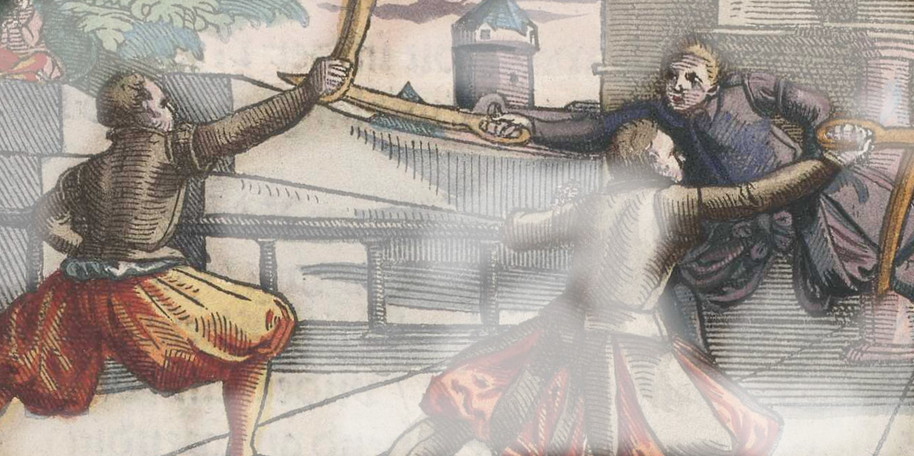
Counters to techniques listed
Meyer lists openings and techniqes according to initial guard, but occasionally he describes a counter to a particular attack he has just illustrated (although in general he does not favour learning specific counters). In this section, such counters are collected.
- if the opponent feints a thrust, pulls back and continues with an Unterhau, cut hard against the Unterhau to get his blade away, then do a horizontal Mittelhau from left to catch his next attack, then continue as needed
- if the opponent uses leftStier or Zornhut in Zufechten, step well right and thrust to his face, if he parries pull back and cut a Mittelhau from the other side through his face
- if the opponent remains low in Bogen, attack his head with an Oberhau, if he reacts to a left Mittelhau to his hand
- if both fencers are low in Bogen, suddenly pull the dusack left and thrust, if he reacts do a left Mittelhau to his hand
- if the opponent catches an attack with a hanging parry and tries to thrust, block and immediately cut a Mittelhau through his face
- if you are in Bogen and the opponent tries to thrust from below, defend against the thrust (exposing your face) and if he tries to attack the face, strike with your hilt between his hands (see illustration below)
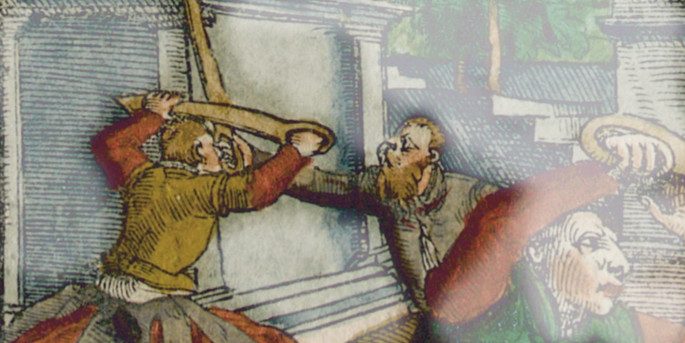
Generally applicable
A few techniques don't seem to be tied to particular guards or other techniques and are listed here:
- cut three Mittelhau right, left, right
- meet an attack with the strong while trying to hit the opponent's head with the tip (see illustration below), follow with thrust
- lure the opponent to attack with a Zornhau, then let your point sink to evade his blade, step and cut on the outside of of his attack to his face
- against fencers who protect their head with their arms and dive under the blade to get close, raise your hand too and cut a quick false-edge cut from the wrist to their face, then do a horizontal false-edge cut to their face, then cover your retreat as needed
- if possible, it is better to let the opponent's cuts miss than to block them
- if you get close and start wrestling, the first action should be to grab his weapon hand wrist with your left hand
- against a high cut, parry high and then grab with your left hand, push the opponent back with the hilt and let him fall across your leg
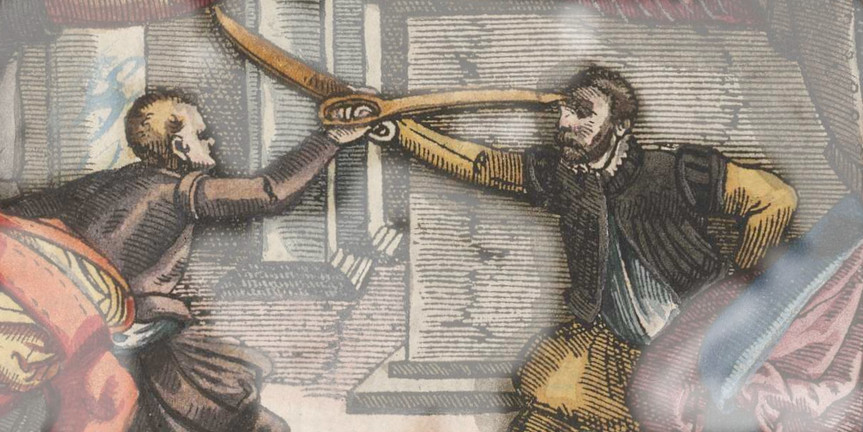
Original quotes (English translations by myself):
(1) Dann in allen Häwen und stucken komestu immer auß einem Läger ins ander.
(2) So solstu für das vierdt wissen, das du in keinem Leger stillzuligen verharren, sondern immerdar von einem Leger ins ander abwechßlen, und solches nicht allein darumb, das du ihn verführest, sonder vil mehr ihn damit irr zumachen, auff das er nicht wissen möge, was für stück auff in gefochten, oder er auff dich, Fechten solle
(3) Dise Versatzung aber soltu nicht verstehen, wie etliche in gewonheit haben, Nemlich das sie ihre Wehr nur darhalten und ihnen lassen drauff schlagen, sondern wiltu einem seinen streich entpfahen und Versetzen, so soltu mit deiner Versatzung von Unden ubersich mit außgestrecktem Arm seinem Oberhauw in die lufft entgegen fahren Dann ihe höher du ihm sein Hauw in der lufft aufffahest, ihe mehr du im den schwechst, unnd kanst deine Nachhäuw nicht allein desto fruchtbarlicher anlegen, sondern auch desto sicherer vollenden.
(4) Zum ersten so bricht der Oberhauw (so du den gegen des mans Dusacken zu der stärck gegen seiner Rechten hand fürest) all ander Häuw, die auff dich gehauwen werden, es sey von Unden, Schlims oder Uberzwerch, Hergegen, so bricht oder nimpt der Zornhauw, oder der uberzwerch Mittelhauwe, den Oberhaw, Demnach, so merck auch, das alwegen zwen gleiche Häuw, die gegen einander mit iren tritten gehauwen werden, einander abtragen und versetzen, doch richt der mit seim Hauwen am meisten auß, der mit seim Wehr im Hauwen Oberhalb des andern kompt
(5) So er aber vor dir steht in einer Hut, also das du ihm nicht kanst durch sein Versatzung hauwen, oder das er sein Versatzung also führet, das du dir nit trauwest ohn schaden dein ersten Reitzhauw zur Blöß zuthun, so merck, oder hab acht, das du als bald mit dem andern streich zu oder gegen seim Wehr durch Hauwest, ihe neher bey seiner Handt
(6) so ist es auch mit dem Fechten also geschaffen, das du nicht leichtlich wissen, oder in eil mercken kanst, was er f&uumr; stück auff dich Fechten wölle, wil geschweigen, das du soltest so behend wissen mögen, wie ihm das zubrechen sey, Darumb halt ichs alzeit mit dem, der vil stuck unnd wenig Brüch kan, als dann auch dieselbige, im Vor und Noch, fürsichtiglich durch Fechten, unnd lasse den andern umb die Brüche sorgen, er aber sey mit stucken also gefaßt, auff das, wo ihm eines gebrochen wirt, er zwei andere an die stat, und schon im werck habe.
Meyer's Fencing Manual on Wiktenauer
Back to main index Back to Swordfighting
Created by Thorsten Renk 2025 - see the disclaimer, privacy statement and contact information.
|



















